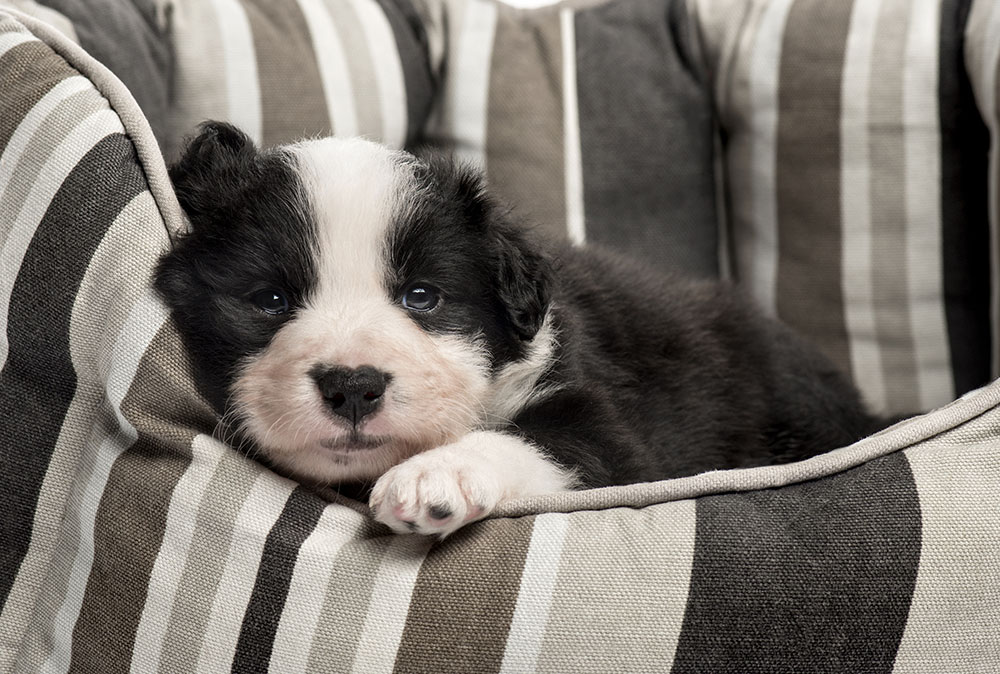

BORDER COLLIE CRATE TRAINING
Border collie crate training carried out properly using positive reinforcement will provide a safe haven for your puppy, somewhere to go when he is stressed or worried about anything, very much like a bedroom for a child. Crates also help with house training and the concept can be transferred to car crates, journeys in the car and giving your dog a safe haven to go to when you are travelling and staying in new places.
If you're not sure where to start or need extra help or advice, we offer special Puppy Training Sessions for only £45 or 3 sessions for £120 that cover anything new puppy related! Get in touch to book a lesson now!
Border Collie Crate Training
Why should I use a crate?
Crates are ideal for brief periods when you can’t supervise the puppy and condition relaxed behaviour, making sure that your puppy gets enough sleep. Getting enough sleep is a vital factor in controlling biting issues in border collies, so it’s important to have a good sleep routing. Giving the pup a safe chew or stuffed kong is ideal for helping him to calm down, settle and sleep. A crate also helps with house training.


You need a crate that is just large enough for your pup to stand up, turn round in and lay out flat. Picking a crate that is too large is not ideal, at least until the puppy is housetrained, as the puppy may use part of the crate for a toilet. (See Border Collie House Training). You can buy a larger crate for when the puppy grows and block off the back of a crate with a large box if necessary.
The crate needs to be easily accessible by your puppy at all times, so that any time he is unsure about anything or needs a sleep, he has somewhere to retire to.
When your puppy first arrives in your home, it is best to have the crate next to you in your bedroom to help the puppy to settle in on his first few nights. You can then gradually move the crate, a few cm at a time, out into the hall/landing and gradually into the room where you would like the pup to eventually sleep. If you do have the crate in your bedroom, and this is not easily accessible to the puppy, then you should also have a crate downstairs, somewhere that both you and the puppy can reach easily. I often find that by the door into the garden is the best place as then, if you return from a muddy walk, you can pop the dog in his crate with a nice chew or kong, where he can hopefully relax and sleep for a while while he dries out.
Start gradually and make the crate a nice place to be. Put the puppy’s bed in there (a bed he has already used) and a nice comfortable mat. NEVER just shut your puppy in without any introduction. In the dog’s mind, the crate must be a wonderful place to be. It must be where treats are given, where he gets his dinner and where he is given a kong/chew, always with the door open.
To commence border collie crate training, follow these steps:
- Toss a treat into the crate for the puppy.
- Once he is going in to collect his treat, add a cue word, such as “bed” or “crate” as you throw in the treat. This will teach the pup that when he hears the word, he should go into his crate and find his treat.
- Once he is going in on cue, give the cue then throw the treat once he is in the crate, so that he is being rewarded for going in on cue.
- Start using a release cue just before the puppy comes out. This could be something like “OK” or “get out”. Say the cue word and toss the treat just outside the crate door so that the pup leaves his crate to reach it. The “out” cue will be useful later, for instance when you want to use a crate in the car and you don’t want your pup to jump straight out onto a busy road as soon as you open the door.
- Practise this for a while until you are sure that the dog understands the cues. At this point, you can drop the treat for the “out” part as coming out of the crate is rewarding in itself.
- When your pup is in the crate, eating his dinner or enjoying a chew, start to get the pup used to having the door shut. To start with, shut the door then open it straight away. If the dog is ok with this, shut the door for a bit longer. Gradually build up very slowly, initially always while the dog is doing something enjoyable in the crate but moving on to times when he has finished his dinner/treat and needs to wait a little while.
- NEVER open the crate door while the dog is whining. If you leave it a bit too long and he whines in frustration, wait until he is quiet for about 3 seconds before letting him out. This is because letting a puppy out while he is whining teaches him very quickly that whining will get him what he wants. If this happens, it will escalate very quickly into whining/barking when he is left and will become a habit that is difficult to break. If dogs are taught that whining won’t get them what they want, but being calm and quiet will, they will quickly learn to be calm and wait patiently.
- Once you have built the dog up to staying calm in the crate for a few minutes with the door shut, repeat but this time move out of sight for a second then immediately return and release the dog. Again, build this up VERY gradually so that you are out of the room for a minute, then two minutes then so on.
- Throughout the whole process, build up very gradually. Never ask for more than your dog can cope with. If he is distressed at a certain stage, wait until he has calmed down, even if just for a couple of seconds, then let him out and next time, go back a stage. It’s important that the dog feels comfortable in the crate and never panics. This process is the start of preventing separation anxiety, which can be a severe problem in border collies, so it is well worth taking your time and getting it right from the start.
- Remember to keep using the cues for going in and out of the crate. These will be very useful when you are travelling and will help to keep your dog safe.
Once training is complete and the dog is not afraid or unwilling to go into the crate, then a rule of thumb is an hour for each month of the puppy’s age, so an 8 week old puppy would be fine for two hours, a 12 week old puppy ok for three hours if you need to nip out. However, as described in the Border Collie House Training page, I would always recommend having a small puppy pen tagged onto the crate so that the door doesn’t have to be shut and your puppy has somewhere to go to relieve himself if needed.
